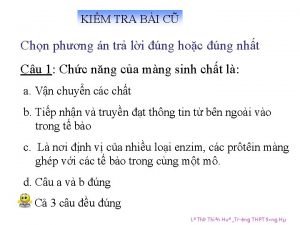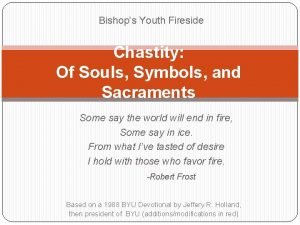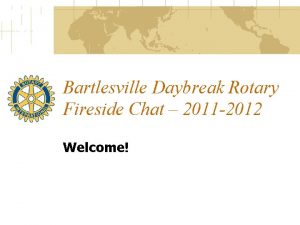CS Department Fireside Chat All are welcome Wed










![l l i t S ! n e op ÎP [2004] l l i t S ! n e op ÎP [2004]](https://slidetodoc.com/presentation_image_h2/78d0a90f33913fe88c52b733cb542279/image-11.jpg)






















- Slides: 33

CS Department Fireside Chat All are welcome! Wed Nov 18, 5 -6 pm, Ols 228 e/236 d Kim Hazelwood and Wes Weimer Meet and ask them questions in a non-academic setting. Learn how they became interested in computer science, what they wish they had known when they were students, and what their lives are like outside of the office. Ask them anything!

from “Complexity of Computer Computations”, pp. 85– 103, 1972.




e t e l p g i r O f. N o in m o C P- ! s s ne




PSPACE-complete P N n i p i en! h s r e p b o l m l Me is sti
![l l i t S n e op ÎP 2004 l l i t S ! n e op ÎP [2004]](https://slidetodoc.com/presentation_image_h2/78d0a90f33913fe88c52b733cb542279/image-11.jpg)
l l i t S ! n e op ÎP [2004]

Problem Transformations Idea: To solve a problem, efficiently transform to another problem, and then use a solver for the other problem: Satisfiability (x+y)(x'+y') Colorability SAT solution x=1, y=0 Colorability solver

Decision vs. Optimization Problems Decision problem: “yes” or “no” membership answer. (x+y+z) Ex: Given a Boolean formula, is it satisfiable? ^(x'+y'+z) ^(x'+y+z') Ex: Given a graph, is it 3 -colorable? Ex: Given a graph & k, does it contain a k-clique? Optimization problem: find a (minimal) solution. Ex: Given a formula, find a satisfying assignment. Ex: Given a graph, find a 3 -coloring. Ex: Given a graph & k, find a k-qlique. Theorem: Solving a decision problem is not harder than solving its optimization version. Theorem: Solving an optimization problem is not (more than polynomially) harder than solving its decision version.

Decision vs. Optimization Problems Corollary: A decision problem is in P if and only if its optimization version is in P. Corollary: A decision problem is in NP if and only if its optimization version is in NP. Building an optimizer from a decider: Satisfiability Decider Ex: what is a satisfying assignemnt of P=(x+y+z)(x'+y'+z)(x'+y+z') ? Idea: Ask the decider 2 related yes/no questions: P P^x Iterate! Satisfiability P^x' Decider Satisfiability Decider yes no x is true x is false yes no Satisfiability Optimizer x is “don’t care” P is not satisfiable

Graph Cliques Graph clique problem: given a graph and an integer k, is there a subgraph in G that is a complete graph of size k? Theorem: The clique problem is NP-complete. Proof: Reduction from 3 -SAT: Literals become nodes; k clauses induce node groups; Connect all inter-group compatible nodes / literals. Example: (x+y+z)(x'+y'+z)(x'+y+z') X' Y' Z Graph clique solver X X' Y Y Z Z' k-clique corresponds to 3 -SAT solution: x = true, y = false, z = false Clique is in NP Þ clique is NP-complete.

Independent Sets Independent set problem: given a graph and an integer k, is there a pairwise non-adjacent node subset of size k? Theorem: The independent set problem is NP-complete. Proof: Reduction from graph clique: Idea: independent set is an “anti-clique” (i. e. , negated clique) Þfinding a clique reduces to finding an independent set in the complement graph: Independent set ÎNP Þ NP-complete. Graph clique solver Independent set solver


Graph Colorability Problem: is a given graph G 3 -colorable? Theorem: Graph 3 -colorability is NP-complete. Proof: Reduction from 3 -SAT. Idea: construct a colorability “OR gate” “gadget”: (x+y+z) Þ x x y x' "x T z T Property: gadget is 3 -colorable iff (x+y+z) is true F

x+y+z x'+y'+z x'+y+z' Example: (x+y+z)(x'+y'+z)(x'+y+z') x x y T y z z T x' F y' T x "x x' z' F

x+y+z x'+y'+z x'+y+z' Example: (x+y+z)(x'+y'+z)(x'+y+z') 3 -colorability Solution: 3 -satisfiability Solution: x = true y = false z = false x y z x' y' T z' F

What Makes Colorability Difficult? Q: Are high node degrees the reason that graph colorability is computationally difficult? A: No! Graph colorability is easy for max-degree-0 graphs Graph colorability is easy for max-degree-1 graphs Graph colorability is easy for max-degree-2 graphs Theorem: Graph colorability is NP-complete for max-degree-4 graphs.

Restricted Graph Colorability Theorem: Graph 3 -colorability is NP-complete for max-degree-4 graphs. Proof: Use “degree reduction” gadgets: 3 -colorability constraint propagation: Gadget properties: a) Gadget has max-degree of 4 b) Gadget is 3 -colorable but not 2 -colorable c) In any 3 -coloring all corners get the same color

Restricted Graph Colorability Idea: combine gadgets into “super nodes”! Local node replacement: High degree Max degree 4 Properties (inherited from simple gadget): a) Super-node has max-degree of 4 b) Super-node is 3 -colorable but not 2 -colorable c) In any 3 -coloring all “corners” get the same color Idea: Use “super nodes” as “fan out” components to reduce all node degrees to 4 or less

Restricted Graph Colorability Example: convert high-degree to max-degree-4 graph Max degree 6 Max-degree-4 colorability solver Max degree 4 Conclusion: Solving max-degree-4 graph colorability is as difficult as solving general graph colorability!

Restricted Graph Colorability Theorem: Planar graph 3 -colorability is NP-complete. Proof: Use “planarity preserving” gadgets: 3 -colorability constraint propagation Gadget properties: a) Gadget is planar and 3 -colorable b) In any 3 -coloring opposite corners get same color c) Pairs of opposite corners are “independent”

Restricted Graph Colorability Local replacement: Planar graph is 3 -colorable IFF original graph was Idea: use gadgets to eliminate edge intersections! ar graph orability solver Conclusion: Solving planar graph colorability is as difficult as solving general graph colorability!

Restricted Graph Colorability Theorem: Graph colorability is NP-complete for planar graphs with max degree 4. Proof: Compose max-degree-4 transformation with planarity preserving transformation: More degree reduction replacements needed here Local intersection replacement Degree reduction replacement Resulting planar max-deg-4 graph is 3 -colorable IFF original graph is!

Planar Graph Colorability Theorem: Planar graph 1 -colorability is trivial. DTIME(n) Theorem: Planar graph 2 -colorability is easy. DTIME(n) Theorem: Planar graph 3 -colorability is NP-complete. ? Theorem: Planar graph 4 -colorability is trivial. DTIME(1) Theorem: All planar graphs have 4 -colorings. Open since 1852; solved by Appel & Haken in 1976 using long computer-assisted proof based on 1936 special cases!

Planar Graph Colorability Theorem: Finding planar graph 4 -coloring is in DTIME(n 2). Theorem: Finding planar graph 5 -coloring is in DTIME(n). Theorem: Graph planarity testing is in DTIME(n). Theorem: 4 -coloring a 3 -colorable graph is NP-hard. Theorem: 7 colors are necessary and sufficient on a torus. Theorem: For a surface of genus G, the number of colors that are both necessary and sufficient is Genus: # colors: 0 4 1 7 2 8 3 9 4 10 5 11 6 12 7 12 8 13

Applications of Graph Coloring Job scheduling: • Need to assign jobs to time slots; • Some jobs conflict (e. g. , use shared resource); • Model jobs as nodes and conflicts as edges; • Chromatic number is “minimum makespan” (optimal time to finish all jobs without conflict) 2 1 4 5 3 3 Jobs & conflicts Coloring Time 1 4 5 2 Time 2 1 3 Time 3 Schedule

Applications of Graph Coloring CPU Register allocation: • Compiler optimizes assignment of variables to registers; • Interference graph: model registers as nodes, and edges represent variables needed simultaneously; • Chromatic number corresponds to minimum # of CPU registers needed to accommodate all the variables. Register 1 2 1 1 4 5 2 Register 2 4 5 Register 3 3 Variables & simultaneity Graph coloring Register allocation


The Extended Chomsky Hierarchy Reloaded 2 S* NP P … … … anbncn Context-free ww. R … … Det. CF anbn … … … Regular a* … … … Finite {a, b} … … … … NP-complete SAT PSPACE-complete QBF EXPTIME-complete Go EXPSPACE-complete =RE … … … Recognizable Not finitely describable Not Recognizable Decidable …………… Presburger arithmetic … … EXPSPACE … … … ? H H … … EXPTIME … Turing … … … PSPACE … … … degrees … … … Context sensitive LBA … … Dense infinite time & space complexity hierarchies Other infinite complexity & descriptive hierarchies … … … … …
 Antigentest åre
Antigentest åre I love the performance of folk song
I love the performance of folk song ưu trương
ưu trương Bishop youth fireside
Bishop youth fireside Short fireside poems
Short fireside poems Henry david thoreau romanticism
Henry david thoreau romanticism Fireside poets
Fireside poets Fireside poets definition
Fireside poets definition Home owners loan corporation apush
Home owners loan corporation apush Draw three noncollinear points j k and l
Draw three noncollinear points j k and l Welcome transport department
Welcome transport department Welcome welcome this is our christmas story
Welcome welcome this is our christmas story No article rules
No article rules Welcome to all delegates
Welcome to all delegates Welcome all delegates
Welcome all delegates Hearty welcome to all
Hearty welcome to all Welcome to all participants
Welcome to all participants Welcome to all participants
Welcome to all participants Welcome to all participants
Welcome to all participants Welcome to all delegates
Welcome to all delegates Welcome to all delegates
Welcome to all delegates Distinguist
Distinguist Wafwa
Wafwa Wicked chat
Wicked chat Xyy
Xyy Natacha n'attacha pas son chat pacha qui s'échappa
Natacha n'attacha pas son chat pacha qui s'échappa Sindromul cri du chat wikipedia
Sindromul cri du chat wikipedia 5 phẩm chất của học sinh
5 phẩm chất của học sinh Type in the chat box
Type in the chat box Tính chất hình thoi
Tính chất hình thoi Ms pyiy
Ms pyiy Aeiou bla bla sala 50+
Aeiou bla bla sala 50+ Cri du chat chromosomal abnormalities
Cri du chat chromosomal abnormalities Usenet message stephanie
Usenet message stephanie

























































